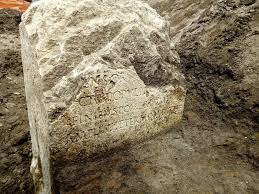Italy: Rome digs up ancient border stone near tomb of city’s first emperor

Rome: Rome archaeologists have unearthed a border stone laid during the reign of Emperor Claudius almost 2,000 years ago, the first such discovery in more than a century.
The ‘pomerium cippus’ – a marker which defined the city’s religious boundary – dates to 49 AD when Claudius expanded the boundaries of the pomerium, a sacred open space in which only Roman gods could be worshipped.
The pomerium, which included the Esquiline, the Palatine, the Quirinal and Capitoline hills, was a consecrated piece of land in which it was forbidden to farm, live or build and beyond which it was forbidden to enter carrying arms.
It was not demarcated by walls but rather by the ‘cippi’ stones, such as the large travertine slab unveiled in Rome yesterday, which delineated the city’s sacred, military and political perimeters.
The inscribed stone was discovered last month during works to redevelop Piazza Augusto Imperatore around the newly-reopened Mausoleum of Augustus, the vast circular tomb in honour of Rome’s first emperor.
The cippus was found in good condition, about 3.5 metres below street level, during works to upgrade the area’s sewers. The stone has been put on temporary display in the nearby Ara Pacis Museum, at the feet of a replica statue of Claudius in the Sala Paladino.
The discovery of the cippus, which will eventually go on permanent display in the Mausoleum of Augustus, is particularly significant as it sheds light on the exact location of the expanded pomerian boundary lines, a contentious move by Claudius, who ruled from 41-54 AD.
“It’s like an extra piece of the jigsaw for the understanding of ancient Roman society,” Claudio Parisi Presicce, head of Rome’s archaeological museums, told reporters.
The stone’s inscription introduces Claudius, list his titles and honours, and “announces to posterity” his decision to expand the pomerium’s borders, according to Parisi Presicce.
“Rome never ceases to amaze” – said the city’s mayor Virginia Raggi – “This is an exceptional find: over time, only ten other memorials relating to the time of Claudius and the most recent, to date, was found in 1909.”
Claudius is believed to have laid down more than 140 cippi around Rome but only 11 have been found. Four of these have been left in their original positions and some are held in the Vatican Museums.





